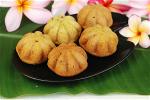 So you’ve done all the mixing and folding; you’ve pre-heated the oven and put your cake in its greased and lined tin. Now you're going to pop it in the oven and hope the magic works. Keeping your fingers crossed that what is going in as a flat wet shapeless layer will come out as a soft risen recognisable cake.
So you’ve done all the mixing and folding; you’ve pre-heated the oven and put your cake in its greased and lined tin. Now you're going to pop it in the oven and hope the magic works. Keeping your fingers crossed that what is going in as a flat wet shapeless layer will come out as a soft risen recognisable cake.Magic!
But it’s not Magic. There are very good scientific reasons for this transformation and understanding them should make you less nervous about cake-making. And if you’re more confident about what you’re doing, your cakes will be better.So here’s a simple introduction to the science of cake baking.
Let's begin at the beginning...
Getting Air into Your Cake
The recipe says to beat together the Fat and Sugar. What are you actually doing when you do that? You’re introducing air into the mix. Sugar crystals have jagged edges that help draw air in to create little bubbles, each with a film of fat. These bubbles cause the mixture to become paler in colour – imagine it as being like foam.Now you’ve got air bubbles in the cake you need to make sure they stay there. The egg you add next will form a layer around the bubbles. When the cake is in the oven and the temperature rises, the air in the bubbles expands making the cake ‘rise’ and the egg layer coagulates or hardens, protecting the bubble, and stopping it collapsing.
The Flour
On to the flour. The Plain and Self-raising Flour that you’ll use for most cakes is soft flour. That means it has a low gluten content. Handling flour – by mixing or kneading - makes the gluten tougher. You don’t want tough gluten so this is why cake recipes will tell you to fold in the flour as gently as possible.The gluten, when wet, becomes stretchy and creates an elastic network around the bubbles. When it gets to the right temperature it will lose its elasticity, the shape will be fixed, and your cake will stay nicely risen.
Baking Powder and Bicarbonate of Soda
Your recipe may tell you to add baking powder or bicarbonate of soda. When this is moistened with the cake mixture, a chemical reaction occurs and carbon dioxide is released, meaning more bubbles in your mixture. However a cake mixture is only able to hold so much gas and if too much raising agent is used, the cake, after rising wonderfully initially, will collapse. So make sure you follow recipe quantities!Cooking Time
Don’t open the oven until at least ¾ of the stated cooking time has elapsed. Letting cold air in can result in a drop in temperature and in your cake! So that’s the science; now let’s look at a few other things that will affect your final product.Naturally the best cakes will result from the best fresh ingredients being used. Organic, free-range, unrefined are all good words to look for!
Fat
If you’re using butter, which you might choose to do for its flavour, make sure it is at room temperature before you start; soft margarine is ideal for most cakes. If oil is used, choose a light vegetable one.Egg?
If not specified, use standard or large eggs. You might need to use extra egg if you use small, or if you only need a little more liquid, use extra milk.Sugar
Caster sugar is the basic cake sugar used for its fine texture. There are, of course, a variety of brown sugars available: your recipe will specify which to use for colour, taste and texture. Honey and syrup are also used. Once you’re confident you might like to experiment with different sugars and see what the result is.Finishing Off
How do you tell if a cake is cooked? Small cakes should be well-risen, nicely coloured and firm to the touch.To test if a large cake is cooked, first press it gently with your finger-tip. It should feel spongy and should spring back when you’ve removed your finger. It should also be starting to come away from the edge of the tin.
You don’t want to do this with a sponge cake but with a more substantial cake you can insert a hot skewer into the centre. If it comes out clean, the cake is cooked; if it has some mixture sticking to it, leave it a bit longer.
An alternative way of seeing if a fruit cake is cooked is to listen to it (yes, really!) If it’s whistling, it’s not ready to come out. When you’re satisfied that the cake is cooked, remove from the oven and allow to cool for a few minutes in the tin. This will give it a chance to shrink away from the sides and it will be easier to get out of its tin before leaving it to cool completely on a wire cooling rack. And that’s cake baking explained for you. It’s not rock-cake science, is it?!
Send comment




